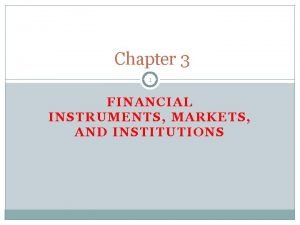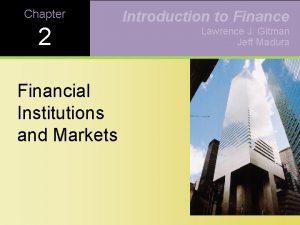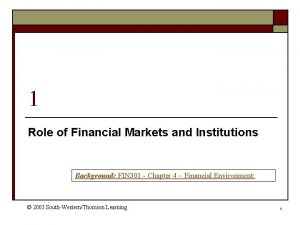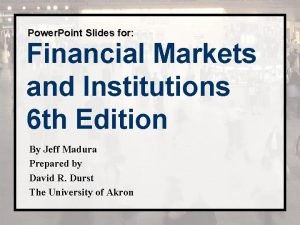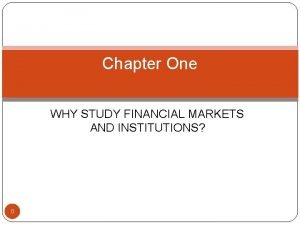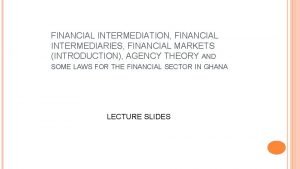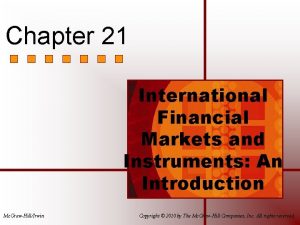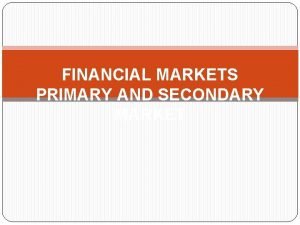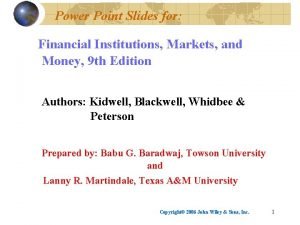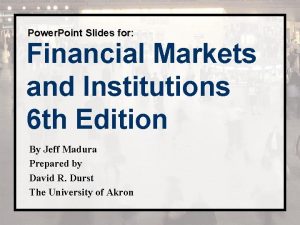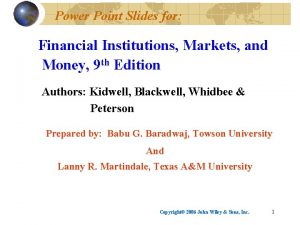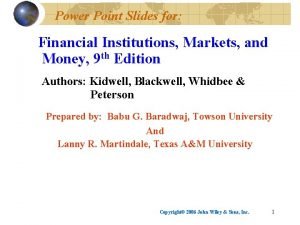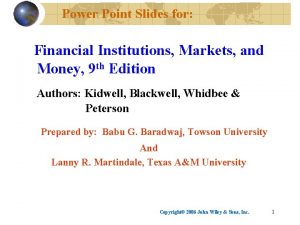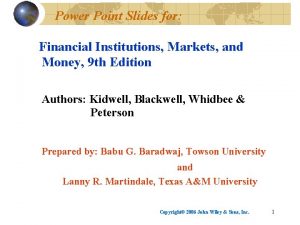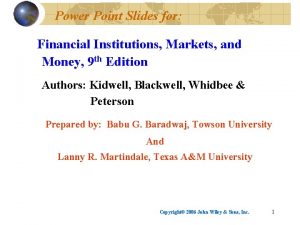Power Point Slides for Financial Institutions Markets and













- Slides: 13

Power Point Slides for: Financial Institutions, Markets, and Money, 9 th Edition Authors: Kidwell, Blackwell, Whidbee & Peterson Prepared by: Babu G. Baradwaj, Towson University And Lanny R. Martindale, Texas A&M University Copyright© 2006 John Wiley & Sons, Inc. 1

CHAPTER 4 THE LEVEL OF INTEREST RATES Copyright© 2005 John Wiley & Sons, Inc

What are Interest Rates? Rental price for money. Penalty to borrowers for consuming before earning. Reward to savers for postponing consumption. Expressed in terms of annual rates. As with any price, interest rates serve to allocate resources. Copyright© 2006 John Wiley & Sons, Inc. 3

The Real Rate of Interest Producers seek financing for real assets. Expected ROI is upper limit on interest rate producers can pay for financing. Savers require compensation for deferring consumption. Time value of consumption is lower limit on interest rate at which savers will provide financing. Real rate occurs at equilibrium between desired real investment and desired saving. Copyright© 2006 John Wiley & Sons, Inc. 4

Loanable Funds Theory Supply of loanable funds— All sources of funds available to invest in financial claims Demand for loanable funds— All uses of funds raised from issuing financial claims Equilibrium interest rate Copyright© 2006 John Wiley & Sons, Inc. 5

Supply of loanable funds— All sources of funds available to invest in financial claims: Consumer savings Business savings Government budget surpluses Central Bank Action Copyright© 2006 John Wiley & Sons, Inc. 6

Demand for Loanable Funds All uses of funds raised from issuing financial claims: Consumer credit purchases Business investment Government budget deficits Copyright© 2006 John Wiley & Sons, Inc. 7

Equilibrium Interest Rate If competitive forces operate in financial sector, laws of supply and demand will bring rates into equilibrium. Equilibrium is temporary or dynamic: Any force that shifts supply or demand will tend to change interest rates. Copyright© 2006 John Wiley & Sons, Inc. 8

Price Expectations and Interest Rates Unanticipated inflation benefits borrowers at expense of lenders. Lenders charge added interest to offset anticipated decreases in purchasing power. Expected inflation is embodied in nominal interest rates: The Fisher Effect. Copyright© 2006 John Wiley & Sons, Inc. 9

Expectations ex ante v. Experience ex post Realized rates of return reflect impact of inflation on past investments. As inflation increases, expected inflation premiums, Pe, may lag actual rates of inflation, Pa, yielding low or even negative actual returns. Copyright© 2006 John Wiley & Sons, Inc. 10

Copyright© 2006 John Wiley & Sons, Inc. 11

Copyright© 2006 John Wiley & Sons, Inc. 12

Interest Rate Movements and Inflation Historically, interest rates tend to change with changes in the rate of inflation, substantiating the Fisher equation. Short-term rates are more responsive to changes in inflation than long-term rates. Copyright© 2006 John Wiley & Sons, Inc. 13
 Why study financial institutions
Why study financial institutions Financial intermediation ppt
Financial intermediation ppt Financial markets and institutions - ppt
Financial markets and institutions - ppt Financial markets instruments and institutions
Financial markets instruments and institutions Madura j. financial markets and institutions
Madura j. financial markets and institutions Functions of financial markets and institutions
Functions of financial markets and institutions Madura j. financial markets and institutions
Madura j. financial markets and institutions Why study financial markets and institutions
Why study financial markets and institutions Chapter 12 money and financial institutions
Chapter 12 money and financial institutions Chapter 12 money and financial institutions
Chapter 12 money and financial institutions Financial intermediaries and markets
Financial intermediaries and markets International financial markets and instruments
International financial markets and instruments Savers and investors role in financial markets
Savers and investors role in financial markets Primary and secondary financial markets
Primary and secondary financial markets



